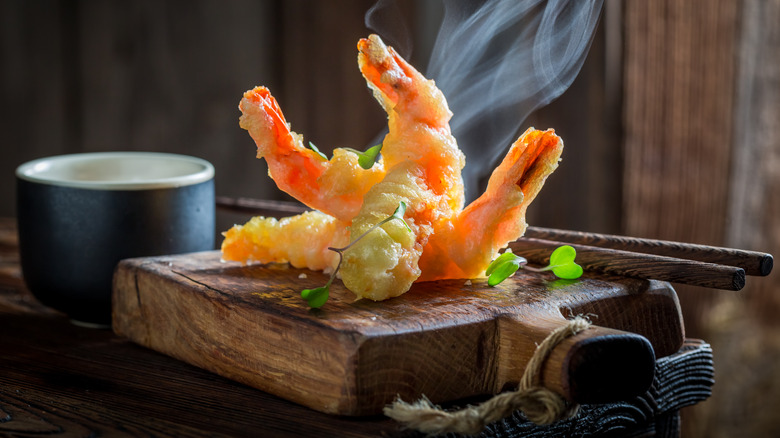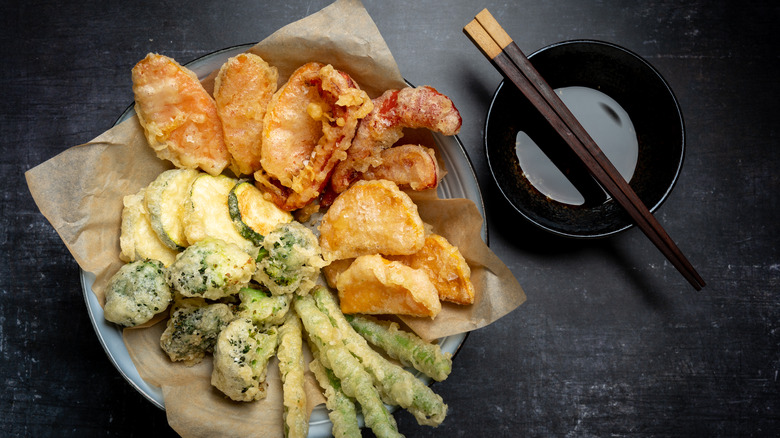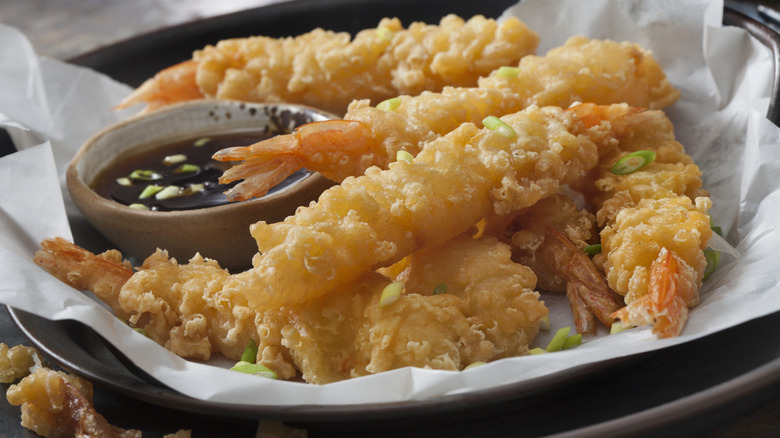Why Making Tempura At Home Is So Tricky, According To An Expert
Tempura is a cooking method common in Japanese cuisine that entails deep frying food in a light batter to give the food an incredibly light, airy, and crispy coating. If you're eating out and you learn that your food has been tempura fried, that means that your food was placed in tempura batter and deep fried to give it that distinctive texture. You'll most often find tempura-fried seafood, sushi, and vegetables, such as asparagus tempura with white sesame and sorrel. It takes time to learn how to perfect tempura frying for many chefs, which can make it even trickier for home cooks. Chef Markee Manaloto, the Executive Chef at the sushi and modern Japanese restaurant Mishik in New York City, explained to Daily Meal how making tempura in your home can be particularly challenging.
In addition to his passion for Japanese cuisine, Chef Manaloto has years of experience working at Japanese restaurants. As the Executive Chef at Mishik, Manaloto is committed to using Japanese cooking techniques for the restaurant's dishes and he has highlighted the obstacles one may face while attempting to cook tempura at home. Manaloto first explained that the cooking method requires a lot of careful attention and precision. Manaloto said, "Tempura can be tricky just because it involves deep-frying foods at high temperatures. You need to work quickly to make sure nothing burns and everything remains crispy." How quick? Some tempura recipes call for deep frying your ingredients for two or three minutes per side.
Tempura requires you to use a lot of oil
A tempura recipe will call for seafood or vegetables to be dipped in batter and then placed in hot oil to be deep fried, which creates that light and airy coating. Some cooks suggest that when making tempura, you should use enough oil to fill half of your cooking pot, which can be a lot. After using all of that oil, Chef Manaloto says home cooks have to make a decision. He explained, "Home cooks would either need to clean and store all that oil or discard it after one use, which isn't ideal."
Cleaning oil after using it to deep fry a tempura dish can be a tedious process. One common method used to remove solids from used oil is pouring the oil in a coffee filter that lines a mesh strainer. The coffee filter should contain the solids while the clean oil drips through the holes in the mesh strainer into a container. While this method is effective, it can take a very long time for the clean oil to slowly drip through the strainer.
Some methods of disposing of used cooking oil can be tedious as well. One of which is waiting for the used oil to cool down, pouring it in an old can, letting it solidify in your freezer, then digging it out with a spoon and dumping it into your trash. Perhaps, no method is more bizarre than the spot Martha Stewart once dumped cooking grease.
Deep frying at home can be tricky for beginners
Some chefs suggest that the optimal temperature for your cooking oil while you deep fry your tempura ingredients is between 350 and 375 degrees Fahrenheit. According to the U.S. Department of Agriculture, deep frying oil can actually reach north of 400 degrees Fahrenheit, which can make cooking tempura at home very dangerous since cooking oil is highly flammable. This can be especially risky for home cooks who are trying to make tempura for the first time. Manaloto warned, "I just always caution people to be careful when deep frying at home, especially people who've never done it before."
There are many mistakes you need to avoid when deep frying. One mistake that home chefs could make during their first try at deep-frying tempura is releasing their ingredients into the hot cooking oil with their fingers. If you drop the ingredients into the oil incorrectly, you will risk the hot cooking oil splashing onto your bare skin, which can cause burns. This is why it's best to use long chopsticks to handle those ingredients. Another mistake those new to deep frying may make is walking away while the tempura ingredients deep fry. Moving the oil around with the chopsticks is crucial to keeping the temperature of the cooking oil steady, which will require home cooks to closely monitor the food throughout the deep-frying process and stir the oil continuously.


